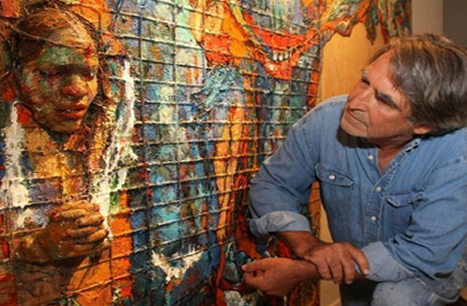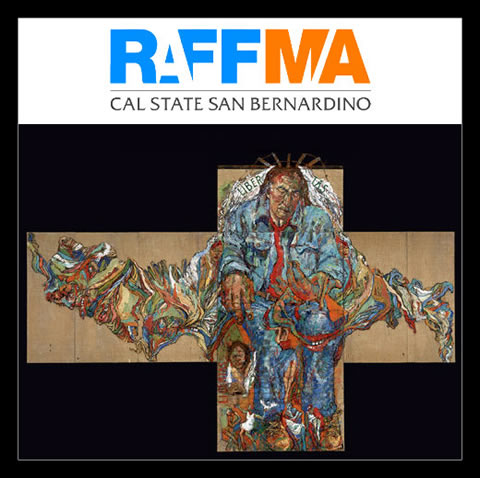

Buy the book direct through PayPal:
or
Click here for an order form and get the book through the mail.
You can also find the book at these fine bookstores:
"The Art of Mark Strickland"
The New High Quality Art Book
On Sale Now
This 278 page book represents 30 years of painting by an important American figurative artist. 187 reproductions are beautifully laid out in this 10.5"x12"px cloth bound edition.
To order the book by mail click the link on the left for a printable order form. (.pdf)
To order the book direct via PayPal click the "Buy Now" button.
- Price: $90.00
- Shipping: $15
- California Sales Tax Applies

View a full preview of the entire book online by clicking here.
Click Here to Enter Mark's Full Portfolio Site
Note: The site uses Flash and Pop-up windows.
Biography
Gallery
Raffma Museum interviews Mark Strickland about his work
December, 2020
UCLA, Hillel 2019 Winter Quarter Exhibition

Lecture of Gregorio Luke on
Mark Strickland at RAFFMA Museum
Spirit Art: Season 1 - Episode 2
[Copyright] at: http://spiritshow.tv/art/episodes/02/
Mark Strickland & Misha Segal's The Forbidden Band™
Mark Strickland & Misha Segal - Museum of Tolerance

Robert and Frances Fullerton Museum of Art
UPCOMING EVENTS
Opening reception for RAFFMA's new exhibition
"All Too Human: The Art of Mark Strickland".
On display: Feb. 17 - May 19, 2018.
Opening reception: Thursday, Feb. 15, 6-8 p.m.
Members-Only Preview: Thursday, Feb. 15, 5:30 p.m.
Address:
5500 University Parkway
San Bernardino, CA 92407-2397
The exhibition will feature deeply emotional and moving artworks highlighting Strickland’s longtime exploration of the human condition, including both the flaws in human nature resulting in tragedies and falls, and the enduring human spirit, dignity and compassion. The artist finds inspiration in the world around him, studying the contemporary struggles of the homeless, immigrants or the ill and combining them with larger concepts relating to the Holocaust, world peace and what it means to be human. Strickland appears in many of his works, along with widely recognizable iconography such as the Statue of Liberty and the Fibonacci sequence. A catalog featuring an essay by well-known art critic and writer Peter Frank will be produced alongside the exhibition.
In conjunction with the exhibition, an artist talk will be held on Thursday, April 19, 6-8 p.m. and will include a mix of music, discussion and live painting.
Strickland has been drawing, painting and sculpting the human form for 40 years. An adjunct professor of art at Art Center College of Design of 34 years (1978-2012), he has also taught at University of California, Los Angeles (1982-1992) and Santa Monica College (1978). He was a drawing course instructor for Walt Disney Imagineering in 2011 and 2015. Strickland received his bachelor’s degree in psychology from UCLA in 1969, then studied art at the Art Center College of Design in Pasadena for three years before earning his master’s degrees in art and psychology from California State University, Long Beach in 1978.
During his long career, the artist has participated in numerous multi-disciplinary projects in Southern California and abroad, including Italy, France and Germany as well as numerous group exhibitions in Southern California and in France.
MUSEUM HOURS
Regular hours:
Monday-Wednesday: 10 am-5 pm
Thursday: 12 pm-8 pm
Saturday: 10 am-5 pm
Friday & Sunday: Closed
General Admission: Free
Suggested donation: $3
Parking: $6
ADDRESS
5500 University Parkway
San Bernardino, CA 92407-2397

THE PROPER STUDY OF MANKIND IS MAN, AND WOMAN: MARK STRICKLAND AND THE FIGURE
By Peter Frank
The human figure, commentators on art assert, is “coming back.” Is such a return due to mere fashion? Did we simply get bored with abstraction and start wanting to see faces and bodies in our art again? Or does the tenor of our times demand that we re-picture our species, that we in effect reconsider our future by musing upon our present? And how do we go about “re-picturing”? The news, true or otherwise, keeps rattling us awake to our condition, but does so in a cascade of bulletins and statistics. “Human interest” stories hit closer to home, but it’s hard to keep reading about the starving child, the suddenly exiled, the exploited, the disenfranchised, the murdered, the manipulated without retreating back into one’s shell, if only to reclaim the energy and hope one needs to keep on living. Art – and perhaps art alone – can address these issues dramatically, with vast generalities given image – re-pictured – in the beautiful frailties of the human form.
In this light, it is easy to understand the particular thrall Mark Strickland’s painting has us in. Strickland’s devotion to the human figure, and to the atrocities and ecstasies it witnesses, has been long-enduring and unwavering. It has survived several art-world resurgences of the figure just as it has several art-world abandonments. It does not in fact depend on the art world. The longer, vaster reach of both Western and non-Western art histories sustains its aesthetic credibility; and Strickland’s unstinting preoccupation with human life, whether as classic theme or as contemporary reality, keeps him cleft to his subject and to the methods he has devised for manifesting that subject in all its glory, terror, debasement, and apotheosis.
Yes, the world now clamors for a figural art of forceful expression and visual grace. This results in great part, as mentioned, from the news we take in daily. But such hunger for the figure also comes out of the current conflation of high and low artistic modalities, the equalizing of value between the museum masterpiece and the comic book. This new artistic democracy has its many pitfalls, but it does awaken an aesthetically challenged populace to the crucial necessity of visual vitality. And, being human, what the populace understands most readily is the human figure, as a locus of meaning in general and as a cipher for themselves and their loved ones. Strickland doesn’t just exploit that understanding; he speaks directly to it, he appeals to the need for people not simply to see pictures, but to see pictures of people.
For all that, Strickland is hardly painting to appeal to people’s eyes. The images he conjures are easy neither on the eyes nor on the soul. Rather, he wants to reach viewers’ hearts, and guts. The people Strickland portrays are by and large caught in various states of torment. He is a virtuosic portrait painter, to be sure, and his faces are compelling for their balanced study of physical visage and emotional intensity: if you don’t know who that is, you still know how she feels. But it is the non-specific human figure – gendered and perhaps aged, but not identified – that serves as Strickland’s existential hero/victim, an everyman thrown against a fate visited on him by both his fellow humans and the forces of nature (forces which human exploiters have perverted in futile attempts to control). It’s an age-old story, and it’s no wonder that so many of Strickland’s largest and most ambitious paintings – murals for all intents and purposes – offer up images of biblical proportions, Dante-esque tumults, horrific events that reach for a Kantian sublime.
Strickland’s painterly style is entirely coherent with his catastrophic view of life. His brush is as volatile as the circumstances he depicts, circumstances that hover at the point where symbol, dream, and actual event converge. His is a classic Expressionist approach, applied to fraught versions of effulgent post-Renaissance murals and the grandes machines of the 19th-century Academy. Indeed, Strickland is nothing if not a neo-Baroque painter, in the swirling, agitated rhythms of his compositions no less than in his concentration on the human figure. His “loaded brush” comes right out of the Venetian Renaissance and fast forwards to the early 20th century, regarding the expressionist touch as a modernist function, a tool for making human existence vibrant and pained even as it is rendered monumental.
In this, Strickland is not simply keeping alive the general tradition of Expressionism but reaffirming its durability particularly in southern California. His restless, fulminatory manner, anchored by a keen sense of composition all but buried beneath the bodies, harks back to the mid-century humanist painting of such local artists as Rico Lebrun, Howard Warshaw, and Connor Everts – as well as to the bumptious and extravagant approach to the human body found in the work of Strickland’s old friend Jirayr Zorthian. Zorthian’s wit set him a little apart from his fellow Los Angeles-area figurative painters two generations back; similarly, Strickland’s mordancy and urgency distinguish him from the growing ranks of contemporary local figurative painters.
So, in fact, does Strickland’s anti-academic attitude. Clearly, he is as indebted as anyone to the exemplary history of Western art. But Strickland is willing to paint things “wrong” – “wrong” colors, “wrong” compositions, “wrong” pictorial combinations – regardless of what techniques the masters themselves employed. This allows for a compelling sense of immediacy in his pictures, as if Strickland’s mind saw the whole image in a hallucinatory flash and as if, as a result, the painting poured forth in one giant effusion from the artist’s hand. Poured forth they have, but not from a single unified forethought: however much (or little) the figures in a large work might be based on preliminary sketches, Strickland rarely envisions a whole picture before painting it, allowing much room for spontaneous addition and subtraction, modulation and reformation along the way. His whole method relies on modification and last-minute decision at least as much as it does on original vision and compositional rigor.
Mark Strickland in effect answers to the human situation by situating humans in questions. Who are we? Why are we in the circumstances we’re in? What does this mean? Will it endure? What is to become of us? The vital subjects of the day rock us, as Strickland attests. But we are in the end most rocked by our own mortality. Our fragility hints, strongly, at the fact that none of us gets out alive. Strickland paints people living and dying at the same time, because that is what we do. What he protests, what anger him to the point of screed, are the myriad insults and exploitations that force us to die more than live. We can’t live forever, but can’t we live decently? Here Strickland’s heart goes out to the friends he renders in his portraits and even more to the anonymous figures he sets in motion so that they seem to answer like acrobats to the challenges posed them by ominous forces. The matters, the circumstances, the force of life and inevitability of death, all these factors comprise our beings, our being, and our beingness. As Strickland keeps reminding us, we are all too human.
Los Angeles
January 2018